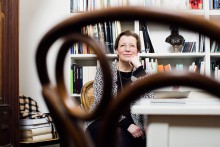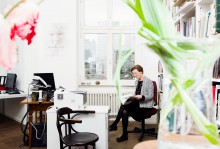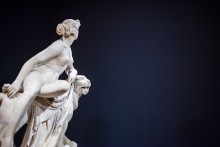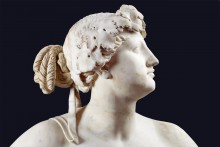Dr Maraike Bückling worked at the Liebieghaus as curator and department head until 2022.
How has the Liebieghaus changed since you started working here?
Since 1985, there has been an extraordinary amount of change at the Liebieghaus. To begin with, the facilities themselves have changed: in 1990 a new wing was built, which has accommodated the antiquities department since that time. As far as the presentation of the permanent exhibition is concerned, the most substantial change took place after Max Hollein took office. For one thing, the rooms in the villa were returned—where possible—to the state they were in when the house still served private purposes. Sculptures no longer included in the permanent display are now in the Open Depot or the Studioli—which, incidentally, used to be used exclusively as administration offices for the museum. What’s more, the works are now presented for the most part in front of colourful—as opposed to white or pastel-shaded—walls.
There have also been major changes in the personnel. At the Liebieghaus we used to be a small team of three scholars, a conservator, two secretaries, two clerks, occasionally also practical trainees or research assistants who were employed for the inventory or exhibition catalogues. These tasks are meanwhile carried out by departments set up especially for the respective purposes and serving both the Städel and the Liebieghaus.
Which sculpture continues to surprise you, even after all these years, and why?
Depending on the scholarly or conservatorial question we pose, every one of our works is capable of surprises—for example when an inscription or well-preserved original polychromy comes to light under a layer of grime during restoration. But stylistic questions, posed anew, can also lead to unexpected findings: for a long time, an altar model was considered the work of a master of Passau. Surprising new document finds in Austria have led to the identification of the real sculptor. Or from the point of view of content, the alabaster bust by Franz Xaver Messerschmidt reveals new facets again and again.
What’s your favourite spot in the museum?
My collection, or—in the case of an incunabulum of Neoclassicism—in front of Dannecker’s Ariadne on the Panther.
Profile
Following her studies in Mainz and Munich, Dr Maraike Bückling came to the Liebieghaus Skulpturensammlung at the end of 1985 to do practical training. She wrote her doctoral thesis on Wilhelm Steinhausen (1846–1924) as a landscape painter. In 2006, after more than twenty years in the position of curator at the Liebieghaus, she became head of the Renaissance to Neoclassicism Collection.
Research focus
Her chief research interest is in European sculpture of the seventeenth and eighteenth centuries.









